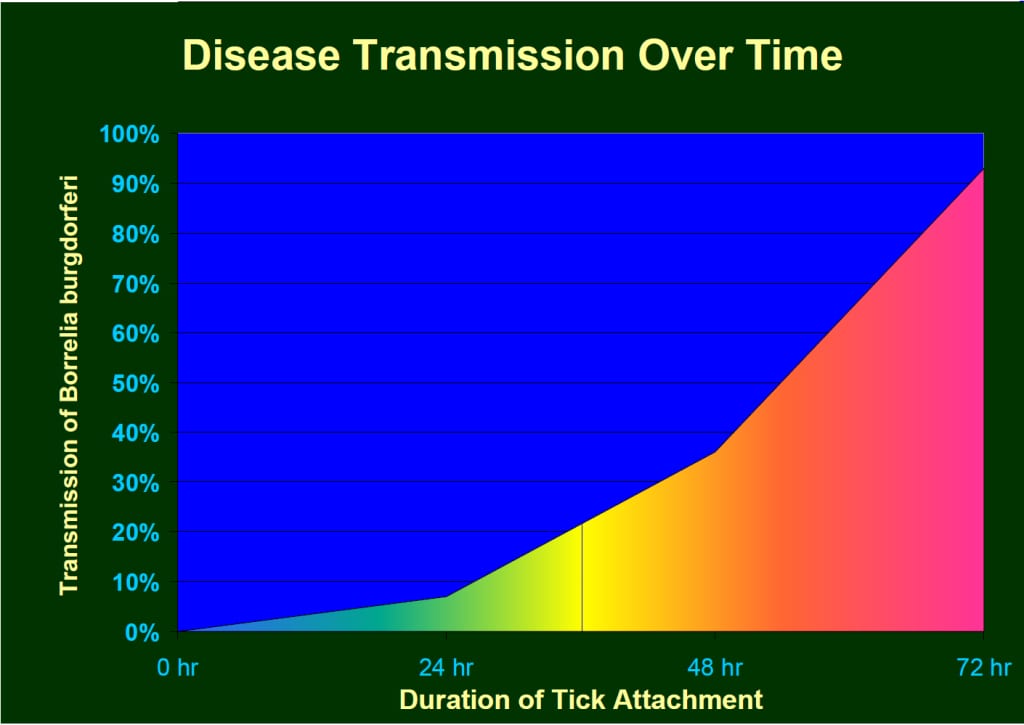HARD SCIENCE ON LYME: Tick Bite Never Zero Risk

During his interview with NPR’s Terry Gross on Fresh Air, journalist Michael Specter got a key piece of information WRONG: that a tick must be attached for at least 36 hours before it can transmit infection.
By Phyllis Mervine
The least controversial information offered by Michael Specter during his interview with Terry Gross concerned prevention, but he still got one major point wrong.
We might forgive “You will often see a bull’s-eye rash,” and another statement that a “majority” develop a bull’s-eye rash, because he also said that many don’t see it. Our search of the peer-reviewed medical literature found at least 20-30% do not develop a rash, and only in 9% of the those had bull’s-eyes.[Smith, 2002, Steere, 2003]
It’s a shame if people don’t recognize Lyme because they expect a rash; they won’t be diagnosed and treated promptly, an important factor in a full recovery.
The unforgivable error was his statement that it takes “at least 36 hours” for a tick to transmit the infection. Specter even mentions there is a debate about how long it takes, but then doesn’t provide details. In fact, a transmission time as low as six hours has been reported [Patmas, 1994] and one study documented transmission in five percent of nymphs attached 24 hours. [Matuschka, 1993] A low risk, but not zero as implied by Specter’s sweeping generalization.
This kind of misinformation has a cost in public health. Doctors and patients alike dismiss the risk if they think the tick has been attached less than the required time, leaving a possible infection to disseminate in the body.
Other details he got right: the importance of removing a tick properly, of saving it to show the doctor, of wearing socks and shoes and using repellent, of checking for ticks.
While we’re grateful to people for shining the spotlight of national media on Lyme, we’d be even more grateful if they got their facts straight first.
This is the last in the series on Michael Specter’s interview on NPR’s Fresh Air with Terry Gross. Read the summary and listen to it yourself here.




















He for sure got many facts wrong. The day the world acknowledges that this disease is transmitted by most every biting insect, sexually transmitted,and that most cases of MS, Parkinson’s, Chronic Fatigue, etc are mostly all Lyme is the day I look forward to. The interviews on Lyme need to come from the highly educated Lyme Doctors.
Deanna, if we stick to the known science, we don’t claim that Lyme is transmitted by every biting insect or sexually transmitted or cause most cases of MS, Parkinsons, etc. Ticks have evolved over time to be an effective vector of Lyme. The spirochetes start multiplying in the gut of the tick when it begins to feed. This is totally unlike what happens in a mosquito, even if a mosquito were carrying a spirochete. Ticks feed over several days. Mosquitos bite and leave. Chemicals in a tick’s saliva help the spirochetes escape the immune system and spread in the body. This does not happen with mosquitos.
There are good arguments against sexual transmission, too. Lyme certainly causes some cases of MS, etc. but “most”? No one really knows and unless more studies are carried out, we can’t make that claim.
I think it’s more helpful to suggest things are “possible,” but not make definite statements about things we really don’t have any evidence for, yet.
Nobody tells you that chronic lyme also can turn to ALS. In fact, they tell you it can. We recently returned from Delhi, India. There were several patients on our floor from our little corner of the northeast all with the same dx. Lyme disease with ALS overlap. Go figure.